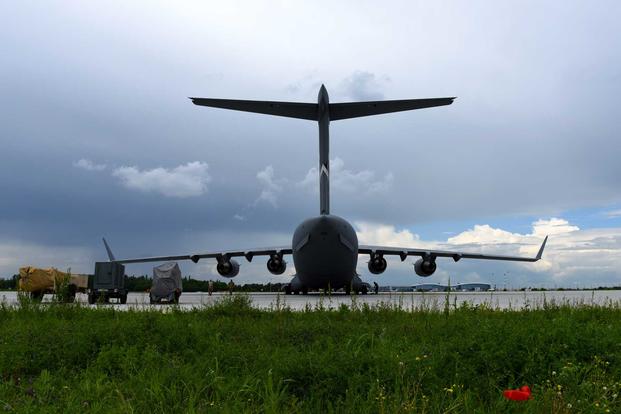JOINT BASE MCGUIRE-DIX-LAKEHURST, N.J. -- In the social media age, U.S. military planners know it is near impossible to move large equipment, like ships and aircraft, without being spotted and having the activity broadcast to the world.
As the Defense Department continues to posture itself to counter China and Russia, one Air Force command is strategizing ways to throw off the enemy by doing everything in plain sight, according to the top general for the Air Force's Air Mobility Command.
"That may mean not going into the predictable places or setting up new predictable places," Gen. Maryanne Miller said. Miller spoke with Military.com during a trip with Chief of Staff Gen. David Goldfein to the base here.
Related: The Days of Secret Military Operations May Soon Be Over. Does That Matter?
Executing that strategy could be as simple as sending a C-5 Supergalaxy aircraft instead of a C-17 Globemaster III, on a cargo mission, or by placing cargo in spots the U.S. typically doesn't operate in, making movements more difficult for observers to interpret.
"An example is, if you drive by a 7-11 [store], is that really a 7-11, or what's really going on in there?" Miller said. "We land places all the time. You can land at MidAmerica [St. Louis] Airport and there may be some customers that are using some of those hangars that do some very special things. But yet when you see that place operate every day, it looks normal."
She continued, "We need the capacity and the capability to just get to where we need to get to, [and that may be] off the beaten track sometimes."
The initiative is part of a larger effort to actually shrink the Air Force's footprint while expanding its reach, added Goldfein. The service has been working on modular bases that would act as small hubs designed to house a quick-reaction force. The Air Force has conducted exercises in Eastern Europe in recent months to see how effectively it can build up, tear down and move to get closer to a potential crisis.
The Air Force may also be able to make use of positions and infrastructure not designed for military purposes.
"For me, the number one [thing] is, 'Do we have the right amount of basing and access to be able to perform the global mobility mission?'" Goldfein said. "The global mobility mission requires a number of bases ... military and civilian, that we routinely exercise and use. Because in a time of crisis or conflict, you don't want to start building your basing access at that point. You actually have to have it."
The Defense Logistics Agency, for example, is working fuel contracts with civilian ports to get more fuel access for Air Force planes, he said.
"We're going to all these different places all the time to make sure that we can move an airplane; every three minutes, there's somebody taking off or landing to do that," Goldfein said.
There are also lessons to be learned from close international partners, Goldfein said.
For example, "India, in the global mobility business, actually operates the highest-altitude C-17 operations on the planet," Goldfein said.
"We have a lot to learn from India in high altitude and mobility operations. And we have a lot to offer India when it comes to global mobility and how we operate back and forth. So that's one example where ... we're more competitive because we ... build trust and confidence at a different level," Goldfein said.
-- Oriana Pawlyk can be reached at oriana.pawlyk@military.com. Follow her on Twitter at @oriana0214.
Read More: 15 Years After Fallujah, Marines Fight to Save Their Comrades












